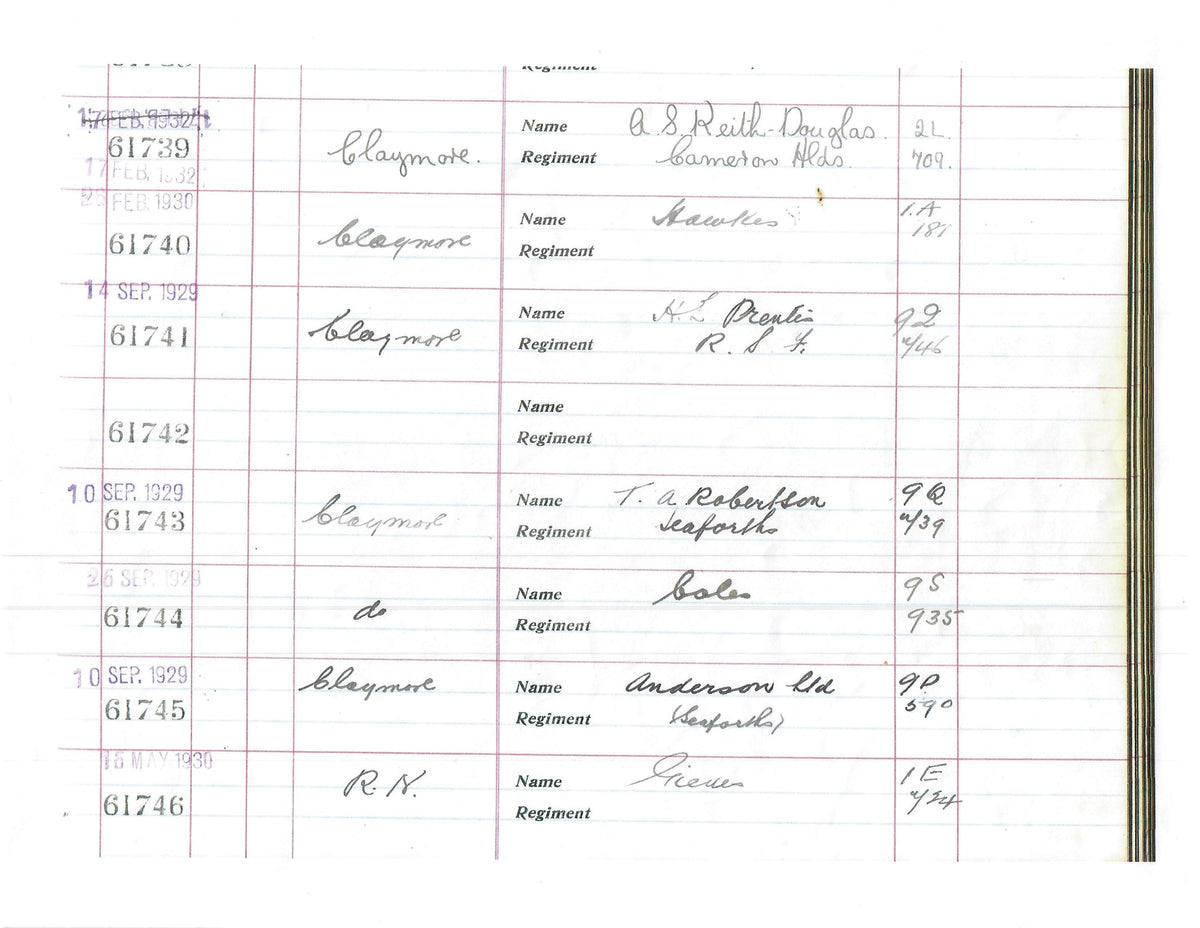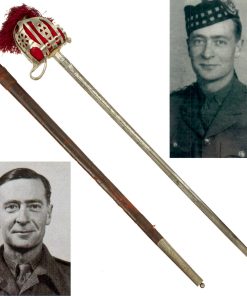Original British WWII Scottish Basket-Hilted Sword Belonging to MI5 Intelligence Officer Lt. Col. Thomas Argyll Robertson Original Items
$ 4.995,00 $ 1.248,75
Original Item: Only One Available. This beautifully engraved and etched basket-hilted sword belonged to Thomas Argyll Robertson who was a Scottish Intelligence officer with MI5 during WW2 and was responsible for the “Double-Cross” (“XX”) disinformation campaign against the German intelligence services, including Operation Mincemeat. The disinformation campaign was successful in persuading the Germans that the invasions of Sicily (1943) and Normandy (D-Day) (6 June 1944) were going to occur elsewhere.
The wonderful book, published in 2011, titled Gentleman Spymaster by Geoffrey Elliott, is biography of Thomas Argyll Robertson, known universally as TAR who played a key role in Operation Mincemeat (the Second World War operation which suggested that an invasion of Greece was imminent) and masterminded the 1944 Operation Fortitude (which was designed to persuade the Germans that the invasion of France would not take place in Normandy but in Pas de Calais). Thomas Argyll Robertson, known universally as Tar, joined MI5 in March 1933, recruited by Vernon Kell, the organization’s founder. He was not formally interviewed for service but was recommended by Kell’s son John, Tar’s contemporary at Charterhouse. In the 1930s MI5 was Vernon Kell’s personal fiefdom and with the help of his wife Constance, it was run very much as a ‘family firm’. At first glance, Tar Robertson may not appear an inspired choice. After Charterhouse and Sandhurst he was commissioned into the Seaforth Highlanders but resigned after two years. He had a spell in the City and somewhat unusually, served in the Birmingham Police Force. But all of these experiences served him well and as an MI5 officer he made an outstanding contribution to Britain’s counter-espionage activities before and during the Second World War. Tar’s deft handling of a widely disparate collection of Double Cross agents, among them criminals, drug addicts and drunks, brought some spectacular military advantages for Britain. The most important by far was Operation Fortitude which fooled the German High Command over the location of the landing of the Allied Invasion Force in June 1944. In another operation Tar’s agents put out masses of false information concerning the hits scored by V1 and V2 rockets which led the Germans to change their target areas which prevented thousands of civilian casualties. Not only were Tar’s agents successful in hundreds of missions, they also proved more than a match for their German counterparts in the Abwehr, who effectiveness was almost totally nullified.nce agencies. MI-5’s official name is the Security Service, but unlike its sister organization MI-6, did not use an abbreviation of its title because SS had already been taken and had a justifiably repulsive connotation. Within MI-5, B Division was the counterespionage branch and within B Division was B1A, the section tasked with double agents. The Chief of B1A being Thomas Argyll Robertson.
This Scottish Basket-Hilt Broadsword and Scabbard was purchased by “TAR” on September 10, 1929 from the Wilkinson Sword Company in London, England. Included in with this sword is a scanned copy of the record of sales from the Wilkinson Sword Company archive where is shows the following information:
10 SEP. 1929, 61743, Claymore, T. a Robertson, Seaforths
A copy of this document is included with purchase as well as a small binder of additional research. There are more names above and below TAR’s name, which we are sure would be worth some additional research.
This straight blade has beautiful floral and patriotic motifs etched into the blade, as well as his unit information. The left side of the blade, the side with his unit insignia, shows the Seaforth Highlanders of Canada Regimental Badge. It consists of the King’s crown above a stag’s head, below which is a scroll marked ‘CUIDICH’N RIGH’ (Help the King), and beneath that are the initials T.A.R.. On the ricasso the sword manufacturer information can still be found:
BY APPOINTMENT
WILKINSON
SWORD
Co LTD
LONDON
On the back side spine of the ricasso MADE IN ENGLAND can be found. On the front facing spine is the sword’s serial number, which matches the number listed on the Wilkinson Sword Co purchase sheet, 61743. The sword and basket are in excellent shape with no major deficiencies. There is minor tarnishing present, as well as some discoloration to the inside and outside of the red “padding” inside of the basket.
The scabbard is of wooden construction with a plated metal scabbard throat and drag. The leather is cracked and torn throughout the scabbard, exposing the inner wood structure. The scabbard is in one piece, however there is a crack on the spine towards the middle. The stamping is still easily visible towards the top, just beneath the throat:
WILKINSON
SWORD COMPANY
LONDON
This sword was also recently featured on the Discovery Channel series Billy Buys Brooklyn featuring William Leroy.
This is an absolutely beautiful sword and to top it off, it’s named to a genuine spy and double agent of WW2!
Dimensions:
Blade Length: 32 ½”
Basket Length/Width: 7” x 6”
Scabbard Length: 34”
Double-Cross System
The Double-Cross System or XX System was a World War II counter-espionage and deception operation of the British Security Service (a civilian organization usually referred to by its cover title MI5). NSDAP agents in Britain – real and false – were captured, turned themselves in or simply announced themselves, and were then used by the British to broadcast mainly disinformation to their controllers. Its operations were overseen by the Twenty Committee under the chairmanship of John Cecil Masterman; the name of the committee comes from the number 20 in Roman numerals: “XX” (i.e. a double cross).
The policy of MI5 during the war was initially to use the system for counter-espionage. It was only later that its potential for deception purposes was realized. Of the agents from the German intelligence services, Abwehr and Sicherheitsdienst (SD), some were apprehended, while many of the agents who reached British shores turned themselves in to the authorities; others were apprehended after they made elementary mistakes during their operations. In addition, some were false agents who had tricked the Germans into believing they would spy for them if they helped them reach England (e.g., Treasure, Fido). Later agents were instructed to contact agents who, unknown to the Abwehr, were controlled by the British. The Abwehr and SD sent agents over by parachute drop, submarine, or travel via neutral countries. The last route was most commonly used, with agents often impersonating refugees. After the war, it was discovered that all the agents Germany sent to Britain had given themselves up or had been captured, with the possible exception of one who committed suicide.
Operation Mincemeat
Operation Mincemeat was a successful British deception operation of the Second World War to disguise the 1943 Allied invasion of Sicily. Two members of British intelligence obtained the body of Glyndwr Michael, a tramp who died from eating rat poison, dressed him as an officer of the Royal Marines and placed personal items on him identifying him as the fictitious Captain (Acting Major) William Martin. Correspondence between two British generals which suggested that the Allies planned to invade Greece and Sardinia, with Sicily as merely the target of a feint, was also placed on the body.
Part of the wider Operation Barclay, Mincemeat was based on the 1939 Trout memo, written by Rear Admiral John Godfrey, the Director of the Naval Intelligence Division and his personal assistant, Lieutenant Commander Ian Fleming. With the approval of the British Prime Minister, Winston Churchill and the military commander in the Mediterranean, General Dwight D. Eisenhower, the plan began by transporting the body to the southern coast of Spain by submarine and releasing it close to shore, where it was picked up the following morning by a Spanish fisherman. The nominally neutral Spanish government shared copies of the documents with the Abwehr, the German military intelligence organisation, before returning the originals to the British. Forensic examination showed they had been read and Ultra decrypts of German messages showed that the Germans fell for the ruse. Reinforcements were shifted to Greece and Sardinia before and during the invasion of Sicily; Sicily received none.
The full effect of Operation Mincemeat is not known, but Sicily was liberated more quickly than anticipated and losses were lower than predicted.
Operation Fortitude
Operation Fortitude was the code name for a World War II military deception employed by the Allied nations as part of an overall deception strategy (code named Bodyguard) during the build-up to the 1944 Normandy landings. Fortitude was divided into two sub-plans, North and South, with the aim of misleading the German High Command as to the location of the invasion.
Both Fortitude plans involved the creation of phantom field armies (based in Edinburgh and the south of England) which threatened Norway (Fortitude North) and Pas de Calais (Fortitude South). The operation was intended to divert Axis attention away from Normandy and, after the invasion on 6 June 1944, to delay reinforcement by convincing the Germans that the landings were purely a diversionary attack.
Fast Shipping with Professional Packaging
Thanks to our longstanding association with UPS FedEx DHL, and other major international carriers, we are able to provide a range of shipping options. Our warehouse staff is expertly trained and will wrap your products according to our exact and precise specifications. Prior to shipping, your goods will be thoroughly examined and securely secured. We ship to thousands clients each day across multiple countries. This shows how we're dedicated to be the largest retailer on the internet. Warehouses and distribution centres can be located throughout Europe as well as the USA.
Note: Orders with more than one item will be assigned a processing date depending on the item.
Before shipping before shipping, we'll conduct a thorough inspection of the items you have ordered. Today, the majority of orders will be delivered within 48 hours. The delivery time will be between 3-7 days.
Returns
The stock is dynamic and we cannot completely manage it because multiple stakeholders are involved, including our factory and warehouse. So the actual stock may alter at any time. It's possible that you may not receive your order once the order has been made.
Our policy is valid for a period of 30 days. If you don't receive the product within 30 days, we are not able to issue a refund or an exchange.
You can only return an item if it is unused and in the same state as the day you received it. You must have the item in its original packaging.
Related products
Uncategorized
Uncategorized
Uncategorized
Uncategorized
Australian WWII Owen MK1 Machine Carbine SMG Custom Fabricated Replica with Sling Original Items
Uncategorized
Uncategorized
Uncategorized
Armoured Fighting Vehicles of the World: AFVs of World War One (Hardcover Book) New Made Items
Uncategorized
Uncategorized
Uncategorized
Band of Brothers ORIGINAL GERMAN WWII Le. F.H. 18 10.5cm ARTILLERY PIECE Original Items
Uncategorized
Uncategorized
Uncategorized
Uncategorized
Angolan Rebel 1970s era 60mm Inert Display Mortar from Angolan Civil War Original Items
Uncategorized
Uncategorized
Uncategorized
Uncategorized












































































